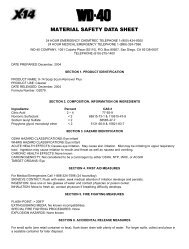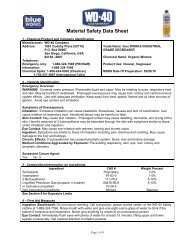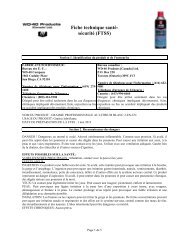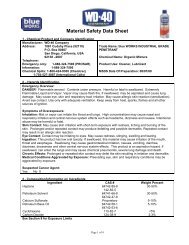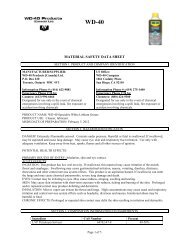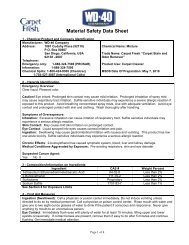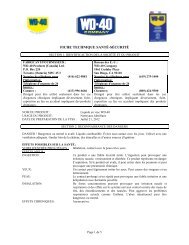Silicone Spray Lubricant - WD-40 Company
Silicone Spray Lubricant - WD-40 Company
Silicone Spray Lubricant - WD-40 Company
You also want an ePaper? Increase the reach of your titles
YUMPU automatically turns print PDFs into web optimized ePapers that Google loves.
Safety Data Sheet1 - Chemical Product and <strong>Company</strong> IdentificationManufacturer: <strong>WD</strong>-<strong>40</strong> <strong>Company</strong>Address: 1061 Cudahy Place (92110)P.O. Box 80607San Diego, California, USA92138 –0607Telephone:Emergency only: 1-888-324-7596 (PROSAR)Information: 1-888-324-7596Chemical Spills: 1-800-424-9300 (Chemtrec)1-703-527-3887 (International Calls)Chemical Name: Organic MixtureTrade Name: 3InOne Pro <strong>Silicone</strong> <strong>Spray</strong>(B017017LY))Product Use: <strong>Lubricant</strong>MSDS Date Of Preparation: 9/10/092 – Hazards IdentificationGHS Classification:Flammable Aerosol, Category 1DANGER! Extremely flammable aerosol. Keep away from heat, sparks, open flames, hot surfaces – Nosmoking. Do not spray on an open flame or other ignition source. Pressurized container: Do not pierce orburn, even after use. Protect from sunlight. Do not expose to temperatures exceeding 50°C (122°F). Disposeof containers in accordance with national regulations.3 - Composition/Information on IngredientsIngredient CAS # Weight Hazard Classification per GHSPercentSiloxane 63148-62-9 10-20 Not HazardousPropane/Butane Propellant 74-98-6 / 106-97-8 80-90 Flammable Gas, Category 14 – First Aid MeasuresIngestion (Swallowed): Ingestion is an unlikely route of exposure. If swallowed, seek medical attention.Eye Contact: Flush thoroughly with water. Remove contact lenses if present after the first 5 minutes andcontinue flushing for several more minutes. Get medical attention if irritation persists.Skin Contact: No first aid should be needed. If irritation develops or for freeze injury, get medical attention.Inhalation (Breathing): If irritation is experienced, move to fresh air. Get medical attention if irritation or othersymptoms develop and persist.5 – Fire Fighting MeasuresExtinguishing Media: Use water fog, dry chemical, carbon dioxide or foam. Cool fire exposed containerswith water.Special Fire Fighting Procedures: Firefighters should always wear positive pressure self-containedbreathing apparatus and full protective clothing. Cool fire-exposed containers with water. Use shielding toprotect against bursting containers.Page 1 of 4
Unusual Fire and Explosion Hazards: Contents under pressure. Keep away from ignition sources andopen flames. Exposure of containers to extreme heat and flames can cause them to rupture often with violentforce. Vapors are heavier than air and may travel along surfaces to remote ignition sources and flash back.6 – Accidental Release MeasuresWear appropriate protective clothing (see Section 8). Eliminate all sources of ignition and ventilate area.Leaking cans should be placed in a plastic bag or open pail until the pressure has dissipated. Contain andcollect liquid with an inert absorbent and place in a container for disposal. Clean spill area thoroughly. Reportspills to authorities as required.7 – Handling and StorageHandling: Avoid contact with eyes. Avoid breathing vapors or aerosols. Use only with adequate ventilation.Keep away from heat, sparks, pilot lights, hot surfaces and open flames. Unplug electrical tools, motors andappliances before spraying or bringing the can near any source of electricity. Electricity can burn a hole in thecan and cause contents to burst into flames. To avoid serious burn injury, do not let the can touch batteryterminals, electrical connections on motors or appliances or any other source of electricity. Wash thoroughlywith soap and water after handling. Keep containers closed when not in use. Keep out of the reach ofchildren. Do not puncture, crush or incinerate containers, even when empty.Storage: Store in a cool, well-ventilated area, away from incompatible materials Do not store above 50°C(122 F) or in direct sunlight. U.F.C (NFPA 30B) Level 3 Aerosol.8 – Exposure Controls/Personal ProtectionChemicalOccupational Exposure LimitsSiloxanePropaneButaneNone Established1000 ppm TWA (ACGIH)No Chinese exposure limit1000 ppm TWA (ACGIH)No Chinese exposure limitThe Following Controls are Recommended for Normal Consumer Use of this ProductEngineering Controls: Use in a well-ventilated area.Personal Protection:Eye Protection: Avoid eye contact. Always spray away from your face.Skin Protection: Avoid spraying directly on skin. Chemical resistant gloves recommended for operationswhere skin contact is likely.Respiratory Protection: None needed for normal use with adequate ventilation.For Bulk Processing or Workplace Use the Following Controls are RecommendedEngineering Controls: Use adequate general and local exhaust ventilation to maintain exposure levelsbelow that occupational exposure limits.Personal Protection:Eye Protection: Safety goggles recommended where eye contact is possible.Skin Protection: Avoid spraying directly on skin. Chemical resistant gloves recommended for operationswhere skin contact is likely.Respiratory Protection: None required if ventilation is adequate. If the occupational exposure limits areexceeded, wear an approved respirator. Respirator selection and use should be based on contaminant type,form and concentration. Follow local regulations and good Industrial Hygiene practice.Work/Hygiene Practices: Wash with soap and water after handling.9 – Physical and Chemical PropertiesBoiling Point: -42°C (propellant) Specific Gravity: 0.53-0.58Solubility in Water: Not Determined pH: Not DeterminedVapor Pressure: 0.6-0.64 Mpa Vapor Density: Greater than 1Page 2 of 4
Percent Volatile: 80-90% VOC: 80-90%Coefficient of Water/OilDistribution:Not Determined Appearance/Odor Clear colorless liquidin a aerosol sprayFlash Point:
16 – Other Information:None.SIGNATURE:TITLE: Director of Global Quality AssuranceREVISION DATE: September 2009 SUPERSEDES: New .Page 4 of 4


